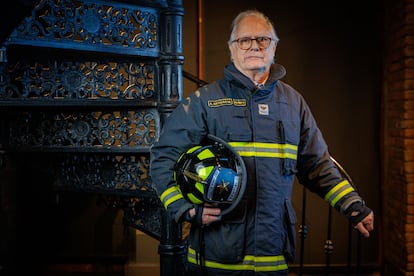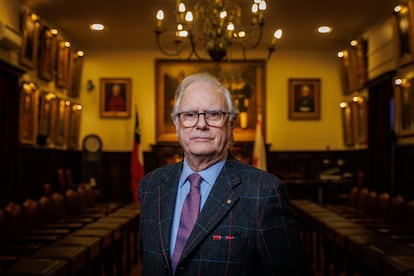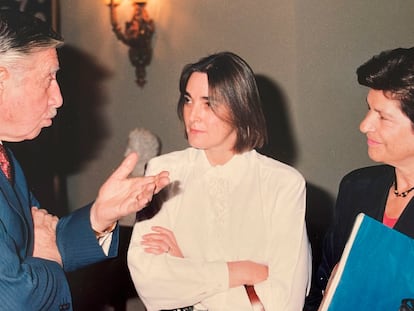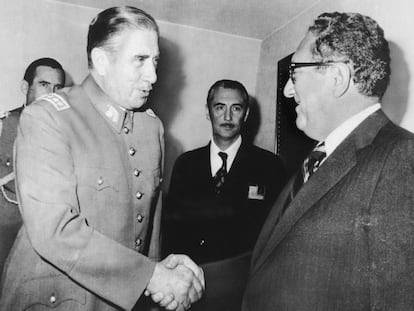The story of the first firefighter who entered Chile’s presidential place, during the 1973 coup: ‘It was total chaos’
Alejandro Artigas, now 74-years-old, describes a ‘Dantean scene’ and ‘a sepulchral silence’ in the office where President Salvador Allende lay dead, after the coup plotters bombed the palace


At six in the morning of September 11, 1973, Chilean Fire Commander Fernando Cuevas called First Lieutenant Alejandro Artigas, of the First Company of Santiago. He ordered him to keep the night watch team at the station until further notice. Artigas — who was 24 years old at the time and a law student at the University of Chile — told him that he had a test that day. He also explained that other firefighters had to go to class or to work. “The order is clear. No one retires,” Cuevas responded. The lieutenant, without knowing the reason for the order, complied. He passed on the message to the 12 men on shift.
Now 74 years old, Artigas affirms that, evidently, there was no plan for what happened that day. “We didn’t have any different information than the rest of the people. And, therefore, we [weren’t at] the scene of the bombing of La Moneda (Chile’s presidential palace) [when it happened],” explains the honorary director of the institution, in a room at the Santiago Fire Department’s headquarters.
Artigas recounts how he was the first firefighter to enter the government palace after the military bombed it. He also explains how he was one of the few firefighters who saw the lifeless body of President Salvador Allende. But, before telling all of this to EL PAÍS, he notes that the fire department is entirely made up of volunteers. It’s a disciplined body made up of civilians, who aren’t under any obligation to serve.
“We work with the authorities, regardless of [political party]. And, in the case of September 11, that was clearly reflected. In all the [fire] companies, there were people from the left, center and right… But on the street, not inside the force. That day, everyone maintained strict respect for each other,” Artigas points out. He has spent more than half-a-century with the institution, having been elected as a captain, commander and superintendent.

Lacking any clear information, the firefighters of the First Company turned on the radio, listening to both the government and opposition stations in search of clues. At eight in the morning, everyone was already aware of a much more powerful military movement than what had been previously seen during the attempted coup of June 29, when tanks moved into the center of Santiago.
On September 11, the firefighters heard the military threaten to bomb the government palace if Allende did not hand over power. Artigas gathered the volunteers he was in charge of. Aware that there was a mixture of different political stripes among the men, the lieutenant asked those who had any personal concerns to make a request to leave the station. “But once the alarm goes off and we have to move, no one backs down,” he warned. None of the volunteers — all young men between the ages of 18 and 28 — excused themselves. “We were all scared to death, but we said, ‘It’s impossible for them to bomb, it’s just an empty threat.’ We didn’t imagine warplanes bombing something in such a calculated manner,” says Artigas, whose company was located just four blocks from La Moneda.
At about 10:30 in the morning, Allende’s historic final speech was given over the radio. Shortly afterward, around noon, the bombardment began. From a small window in the station, the volunteers from the first company saw a flash and, seconds later, heard the roar. “That’s when we realized that this was a war situation — the shots were heard everywhere.” The firefighter remembers the integrity of his colleagues, but also the concern, not only for themselves, but also for their families, their jobs and their political positions. “Nobody knew what was going to happen; if [the military regime] was going to last a month, or the 17 years that it lasted. We had no idea who Mr. Pino [General Augusto Pinochet] was… He had been appointed commander-in-chief, but we hardly knew who he was,” he adds.
They watched as the flames consumed the palace and listened to the sound of machine guns. Did they feel powerless for not being able to go out? “We felt a sense that we weren’t doing what we needed to do. Later, we found out that the Santiago Military Garrison was coordinating with the commander so that the firefighters could put out the fires once the situation was under control, so that we wouldn’t be cannon fodder,” Artigas recalls. At the time, he had been a volunteer firefighter for seven years.
At 2:55 p.m., the order was given. The Santiago Fire Brigade attended to the fire at La Moneda, the one in the Socialist Party headquarters and the one in President Allende’s house on Tomás Moro street, among others. Some nine companies went to the government palace. Within a minute, Artigas’ team was entering through the door at Morandé 80, which later remained closed for decades. “There was total chaos. Everybody was giving orders.” Lieutenant Artigas — the first to enter and lay out an action plan — saw how the fire was had consumed the second floor; there was practically no roof left in the north zone. The opening to the sky ensured that the smoke wouldn’t accumulate, but the darkness of the sky still made vision difficult.
After an hour of work, the captain of the First Company arrived to assume the leadership role. Artigas explains that the first hours consisted of putting out the violent fire, which had spread to several buildings in the area. Amid the stress, firefighters and the military spread the word through the corridors that Allende was dead. When the lieutenant reached the second floor, he asked the fire department to illuminate Independence Hall, where the president had taken his own life.
Artigas’s company didn’t have their flashlights with them, so a volunteer from another company delivered them. “The young man who was at the door of the hall was tremendously affected. I offered him help. It was one of those things that you do without being aware; it wasn’t my job, it was almost against protocol,” he points out. He regained his focus and entered the room.
Light was required because the authorities requested that a journalist film the scene. Among those present were General Javier Palacios — who gave the orders —, a fire captain and several soldiers. “I couldn’t say who, because that day, the uniforms had no [visible rank]. You looked, and you didn’t know if [the soldier] was a corporal or a colonel. They were wearing colored bracelets,” Artigas recalls. “It was a gruesome scene. There was a sepulchral silence.” He recounts that Allende was lying dead on a sofa, dressed in a turtleneck sweater and cloth pants. He saw the rifle between his legs and his glasses on the floor. The firefighter had the three statements he later made before the democratic justice system corrected, so that every time Allende was named, they would put “President Allende.”
“Because [above all] I’m a firefighter,” he clarifies. “Alejandro Artigas is another [person],” he affirms. The correction was made out of respect.
When he returned to work, the then-lieutenant confesses that he wondered what he was doing there, who had sent him. He heard rumors that other troops were coming to defend the government. Artigas and his colleagues thought that they were going to be “the ham in the sandwich.”
At 10:00 p.m., Commander Cuevas ordered the 200 volunteer firefighters who were in the building to leave. There was no water left. However, they knew that, the next day, they would have to return. Even weeks later, Artigas notes, he was still seeing smoke coming out of La Moneda.

Artigas — who lived in the fire station’s living quarters when he was young — would go on to get married. Today, he’s the father of four children and the grandfather of three. His eyes shine like a child’s when he talks about the work done by his institution, his former home. The level of commitment and service put to the test on September 11 of 1973 continues to be seen in every major event that shakes Chile, whenever the firefighters have to step in.
Sign up for our weekly newsletter to get more English-language news coverage from EL PAÍS USA Edition
Tu suscripción se está usando en otro dispositivo
¿Quieres añadir otro usuario a tu suscripción?
Si continúas leyendo en este dispositivo, no se podrá leer en el otro.
FlechaTu suscripción se está usando en otro dispositivo y solo puedes acceder a EL PAÍS desde un dispositivo a la vez.
Si quieres compartir tu cuenta, cambia tu suscripción a la modalidad Premium, así podrás añadir otro usuario. Cada uno accederá con su propia cuenta de email, lo que os permitirá personalizar vuestra experiencia en EL PAÍS.
¿Tienes una suscripción de empresa? Accede aquí para contratar más cuentas.
En el caso de no saber quién está usando tu cuenta, te recomendamos cambiar tu contraseña aquí.
Si decides continuar compartiendo tu cuenta, este mensaje se mostrará en tu dispositivo y en el de la otra persona que está usando tu cuenta de forma indefinida, afectando a tu experiencia de lectura. Puedes consultar aquí los términos y condiciones de la suscripción digital.
More information
Archived In
Últimas noticias
Most viewed
- Sinaloa Cartel war is taking its toll on Los Chapitos
- Oona Chaplin: ‘I told James Cameron that I was living in a treehouse and starting a permaculture project with a friend’
- Reinhard Genzel, Nobel laureate in physics: ‘One-minute videos will never give you the truth’
- Why the price of coffee has skyrocketed: from Brazilian plantations to specialty coffee houses
- Silver prices are going crazy: This is what’s fueling the rally










































